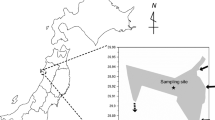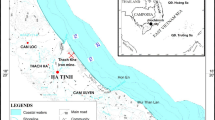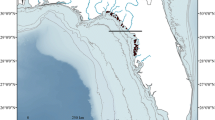Abstract
Large areas of uncompacted cyanobacterial accumulations (or “gyttja”) have been observed in Myall Lake, New South Wales, Australia. To determine whether the cyanobacterial accumulations were assimilated into the local food web, carbon and nitrogen stable isotopes were used to identify the primary food sources of a primary consumer in Myall Lake, the freshwater atyid shrimp Paratya australiensis. Suspended particulate organic matter (POM) and the macrophyte Myriophyllum salsugineum were identified as major dietary sources of P. australiensis. Enriched stable isotope signatures (δ13C and δ15N) of shrimp from gyttja-affected sites, relative to shrimp from unaffected locations, also indicated that P. australiensis were deriving a considerable portion of their dietary carbon and nitrogen requirements from gyttja. Stable isotope mixing models estimated that cyanobacterial accumulations might constitute up to 69% of P. australiensis biomass carbon and nitrogen requirements at gyttja-affected locations. To our knowledge, this is the first study to use stable isotope analysis to trace the assimilation of potentially toxic cyanobacterial accumulations into the trophic pathways of an affected system.






Similar content being viewed by others
References
Ahlgran, G., I.-B. Gustafsson & M. Boberg, 1992. Fatty acid content and chemical composition of freshwater microalgae. Journal of Phycology 28: 37–50.
Bauld, J., 1986. Benthic microbial communities of Australian saline lakes. In De Deckker, P., & W. D. Williams (eds), Limnology in Australia. Dr. W. Junk Publishers, Dordrecht, 95–111.
Boon, P. I., S. E. Bunn, J. D. Green & R. J. Shiel, 1994. Consumption of Cyanobacteria by freshwater zooplankton: implications for the success of ‘top-down’ control of cyanobacterial blooms in Australia. Australian Journal of Marine and Freshwater Research 45: 875–887.
Bowling, L. C. & P. D. Baker, 1996. Major Cyanobacterial Bloom in the Barwon-Darling River, Australia, in 1991, and Underlying Limnological Conditions. Marine and Freshwater Research 47: 643–657.
Bunn, S. E. & P. I. Boon, 1993. What sources of carbon drive food webs in billabongs? A study based on stable isotope analysis. Oecologia 96: 85–94.
Burns, C. W. & B. Hegarty, 1994. Diet selection by copepods in the presence of cyanobacteria. Journal of Plankton Research 16: 1671–1690.
Burns, A. & K. F. Walker, 2000. Biofilms as food for decapods (Atyidae, Palaemonidae) in the River Murray, South Australia. Hydrobiologia 437: 83–93.
Burns, C. W. & Z. Xu, 1990. Calanoid copepods feeding on algae and filamentous cyanobacteria: rates of ingestion, defaecation and effects on trichome length. Journal of Plankton Research 12: 201–213.
Chen, J. & P. Xie, 2005. Tissue distributions and seasonal dynamics of the hepatotoxic microcystins-LR and -RR in two freshwater shrimps, Palaemon modestus and Macrobrachium nipponensis, from a large shallow, eutrophic lake of the subtropical China. Toxicon 45: 615–625.
Dasey, M., N. Ryan, J. Wilson, G. McGregor, L. Fabbro, B. A. Neilan, B. P. Burns, H. Kankaanpää, L. F. Morrison, G. A. Codd, D. Rissik & L. Bowling, 2004. Investigations into the taxonomy, toxicity and ecology of benthic cyanobacterial accumulations in Myall Lake, Australia. Marine and Freshwater Research 56: 45–55.
Davie, P. J. F., 2002. Crustacea: Malacostraca: Phyllocarida, Hoplocarida, Eucarida (Part 1). In Wells, A., & W. W. K. Houston (eds), Zoological Catalogue of Australia, Vol. 19.3A. CSIRO Publishing, Melbourne, Australia.
DeMott, W. R., 1998. Utilization of a cyanobacterium and a phosphorus-deficient green alga as complementary resources by daphnids. Ecology 79: 2463–2481.
DeMott, W. R. & F. Moxter, 1991. Foraging on cyanobacteria by copepods: responses to chemical defenses and resource abundance. Ecology 72: 1820–1834.
Engström, J., M. Viherluoto & M. Viitasalo, 2001. Effects of toxic and non-toxic cyanobacteria on grazing, zooplanktivory and survival of the mysid shrimp Mysis mixta. Journal of Experimental Marine Biology and Ecology 257: 269–280.
France, R. L. & R. H. Peters, 1997. Ecosystem differences in the trophic enrichment of 13C in aquatic food webs. Canadian Journal of Fisheries and Aquatic Sciences 54: 1255–1258.
Gemmell, P., 1978. Feeding habits and structure of the gut of the Australian freshwater prawn Paratya australiensis Kemp (Crustacea, Caridea, Atyidae). Proceedings of the Linnean Society of New South Wales 103: 209–216.
Goedkoop, W., N. Akerblom & M. H. Demandt, 2006. Trophic fractionation of carbon and nitrogen stable isotopes in Chironomus riparius reared on food of aquatic and terrestrial origin. Freshwater Biology 51: 878–886.
Hamill, K. D., 2001. Toxicity in benthic freshwater cyanobacteria (blue-green algae): first observations in New Zealand. New Zealand Journal of Marine and Freshwater Research 35: 1057–1059.
Hancock, M. A. & S. E. Bunn, 1997. Population dynamics and life history of Paratya australiensis Kemp, 1917 (Decapoda: Atyidae) in upland rainforest streams, south-eastern Queensland, Australia. Marine and Freshwater Research 48: 361–369.
Howell, T., L. J. Laurenson, J. H. Myers & P. L. Jones, 2004. Spatial, temporal and size-class variation in the diet of estuary perch (Macquaria colonorum) in the Hopkins River, Victoria, Australia. Hydrobiologia 515: 29–37.
Johannsson, O. E., M. F. Leggett, L. G. Rudstam, M. R. Servos, M. Ali Mohammadian, G. Gal, R. M. Dermott & R. H. Hesslein, 2001. Diet of Mysis relicta in Lake Ontario as revealed by stable isotope and gut content analysis. Canadian Journal of Fisheries and Aquatic Sciences 58: 1975.
Kankaanpää, H., J. Holliday, H. Schröder, T. J. Goddard, R. von Fister & W. W. Carmichael, 2005. Cyanobacteria and prawn farming in northern New South Wales, Australia–a case study on cyanobacteria diversity and hepatotoxin bioaccumulation. Toxicology and Applied Pharmacology 203: 243–256.
Keough, J. R., M. E. Sierszen & C. A. Hagley, 1996. Analysis of a Lake Superior coastal food web with stable isotope analysis. Limnology and Oceanography 41: 136–146.
Koski, M., J. Engström & M. Viitasalo, 1999. Reproduction and survival of calanoid copepod Euryemora affinis fed with toxic and non-toxic cyanobacteria. Marine Ecology and Progress Series 186: 187–197.
Leberer, T. & S. G. Nelson, 2001. Factor affecting the distribution of atyidae shrimps in two tropical insular rivers. Pacific Science 55: 389–398.
Macko, S. A. & M. L. F. Estep, 1984. Microbial alteration of stable nitrogen and carbon isotopic compositions of organic matter. Organic Geochemistry 6: 787–790.
Magalhães, V. F., M. M. Marinho, P. Domingos, A. C. Oliveira, S. M. Costa, L. O. Azevedo & S. M. F. O. Azevedo, 2003. Microcystins (cyanobacteria hepatotoxins) bioaccumulation in fish and crustaceans from Sepetiba Bay (Brazil, RJ). Toxicon 42: 289–295.
Matveev, V., L. Matveeva & G. J. Jones, 1994. Study of the Ability of Daphnia carinata King to Control Phytoplankton and Resist Cyanobacterial Toxicity: Implications for Biomanipulation in Australia. Australian Journal of Marine and Freshwater Research 45: 889–904.
McCutchan , J. H. Jr, W. M. Lewis Jr, C. Kendall & C. C. McGrath, 2003. Variation in trophic shift for stable isotope ratios of carbon, nitrogen, and sulfur. Oikos 102: 378–390.
Mez, K., K. A. Beattie, G. A. Codd, K. Hanselmann, B. Hauser, H. Naegeli & H. R. Preisig, 1997. Identification of a microcystin in benthic cyanobacteria linked to cattle deaths on alpine pastures in Switzerland. European Journal of Phycology 32: 111–117.
Miller, B., 1979. Ecology of the Little Black Cormorant, Phalacrocorax sulcirostris, and Little Pied Cormorant, P. melanoleucos, in Inland New South Wales I. Food and Feeding Habits. Australian Wildlife Research 6: 79–95.
Müller-Navarra, D., 1995. Evidence that a highly unsaturated fatty acid limits Daphnia growth in nature. Arch. Hydrobiol. 132: 297–307.
NPWS, 2002. Myall Lakes National Park, Little Broughton Island and Stormpetrel Nature Reserves: Plan of Management. NSW National Parks and Wildlife Service, Hunter Region, NSW.
Phillips, D. L. & J. W. Gregg, 2003. Source partitioning using stable isotopes: coping with too many sources. Oecologia 136: 261–269.
Pinho, G. L. L., C. Moura da Rosa, J. S. Yunes, C. M. Luquet, A. Bianchini & J. M. Monserrat, 2003. Toxic effects of microcystins in the hepatopancreas of the estuarine crab Chasmagnathus granulatus (Decapoda, Grapsidae). Comparative Biochemistry and Physiology Part C 135: 459–468.
Piola, R. F., S. K. Moore & I. M. Suthers, 2006. Carbon and nitrogen stable isotope analysis of three types of oyster tissue in an impacted estuary. Estuarine, Coastal and Shelf Science 66: 255–266.
Porter, K. G. & G. D. Orcutt, 1980. Nutritional adequacy, manageability, and toxicity as factors that determine food quality of green and blue-green algae for Daphnia. American Society of Limnology and Oceanography. Special Symposium 3: 268–281.
Pringle, C. M., 1996. Atyid shrimps (Decapoda: Atyidae) influence the spatial heterogeneity of algal communities over different scales in tropical montane streams, Puerto Rico. Freshwater Biology 35: 125–140.
Richardson, A. J., J. E. Growns & R. A. Cook, 2004. Distribution and life history of caridean shrimps in regulated lowland rivers in southern Australia. Marine and Freshwater Research 55: 295–308.
Russell-Hunter, W., 1970, Aquatic Productivity: An Introduction to Some Basic Aspects of Biological Oceanography and Limnology. Macmillan, New York.
Sheldon, F. & K. F. Walker, 1997. Changes in biofilms induced by flow regulation could explain extinctions of aquatic snails in the lower River Murray, Australia. Hydrobiologia 347: 97–108.
Sheldon, F. & K. F. Walker, 1998. Spatial distribution of littoral invertebrates in the lower Murray–Darling River system, Australia. Marine and Freshwater Research 49: 171–182.
Vander Zanden, J. M. & J. B. Rasmussen, 2001. Variation in δ15N and δ13C trophic fractionation: Implications for aquatic food web studies. Limnology and Oceanography 46: 2061–2066.
Vasconcelos, V., S. Oliveira & F. O. Teles, 2001. Impact of a toxic and a non-toxic strain of Microcystis aeruginosa on the crayfish Procambarus clarkii. Toxicon 39: 1461–1470.
Williams, W. D., 1977. Some aspects of the ecology of Paratya australiensis (Crustacea, Decapoda: Atyidae). Australian Journal of Marine and Freshwater Research 28: 403–415.
Acknowledgements
We thank S. Moore, K. Wright and J. Everett for field assistance and advice, and J. Wilson and our three referees for their helpful comments and many suggested improvements to the final manuscript. We also thank R. Diocares at Griffith University for all stable isotope sample analysis. This study was partly supported by funding from the New South Wales Department of Infrastructure, Planning and Natural Resources.
Author information
Authors and Affiliations
Corresponding author
Additional information
Guest editors: J. Wilson, L. Bowling & J. Tibby
The Myall Lakes: patterns and processes in an unusual coastal lake system in eastern Australia
Rights and permissions
About this article
Cite this article
Piola, R.F., Suthers, I.M. & Rissik, D. Carbon and nitrogen stable isotope analysis indicates freshwater shrimp Paratya australiensis Kemp, 1917 (Atyidae) assimilate cyanobacterial accumulations. Hydrobiologia 608, 121–132 (2008). https://doi.org/10.1007/s10750-008-9374-4
Published:
Issue Date:
DOI: https://doi.org/10.1007/s10750-008-9374-4




